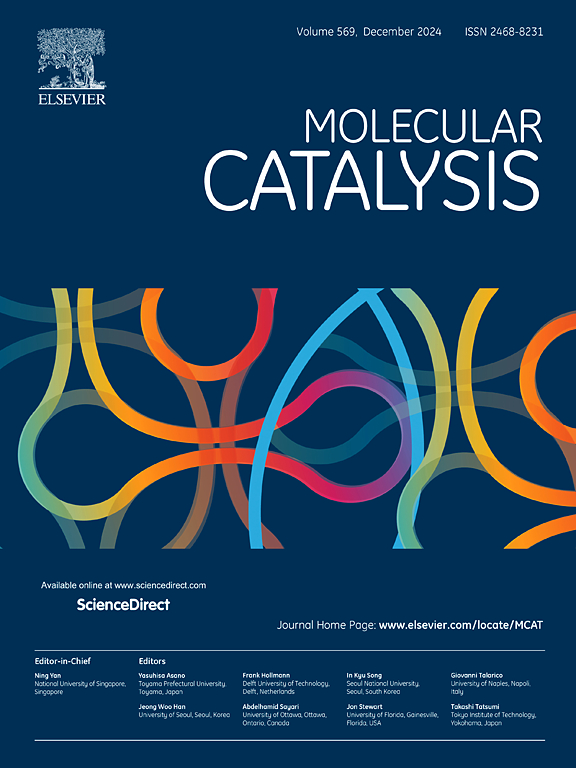在 2-Methyl-THF 中使用 Cu NPs 装饰微晶纤维素合成吡咯并[2,1-a]异喹啉类化合物:一种可生物降解的、可持续级联方法的恒定纳米催化剂
IF 4.9
2区 化学
Q2 CHEMISTRY, PHYSICAL
引用次数: 0
摘要
以微晶纤维素(MCC)为载体的铜纳米颗粒(Cu NPs)是一种高效、可生物降解的异相纳米催化剂,可在温和、可持续的反应条件下,通过涉及缩合、加成、氧化和环化反应的级联反应合成吡咯并[1,2a]异喹啉。催化剂通过各种技术进行了全面表征,包括傅立叶变换红外光谱、PXRD、XPS、FE-SEM、EDX、TEM 和 HR-TEM 分析。优化后的反应条件有助于在 2-Me THF 溶剂中高产生产出各种吡咯并[1,2a]异喹啉类化合物,该方法还具有可扩展性,成功实现了克级合成。值得注意的是,催化剂可重复使用长达五个周期,而活性不会显著降低。这种方法符合生态友好原则,化合物 4a 具有良好的绿色化学指标,包括工艺质量强度低(7.83)、环境影响因子最小(6.83)、原子经济性高(67.56%)、反应质量效率高(60.76%)、化学收率高(92.37%)、质量强度低(1.64)、质量生产率高(60.97%)、碳效率高(69.15%)和效率最佳(89.93%)。这些结果凸显了所开发合成方法的可持续性和环保意识。本文章由计算机程序翻译,如有差异,请以英文原文为准。
![Synthesis of Pyrrolo [2,1-a]isoquinolines using Cu NPs decorated microcrystalline cellulose in 2-Methyl-THF: A biodegradable heteregeneous nanocatalyst for the sustainable cascade approach](https://img.booksci.cn/booksciimg/2024-9/98292904881757826064.jpg)
Synthesis of Pyrrolo [2,1-a]isoquinolines using Cu NPs decorated microcrystalline cellulose in 2-Methyl-THF: A biodegradable heteregeneous nanocatalyst for the sustainable cascade approach
Copper nanoparticles (Cu NPs) supported on microcrystalline cellulose (MCC) serve as an efficient and biodegradable heterogeneous nanocatalyst for the synthesis of pyrrolo [1,2a] isoquinoline under mild and sustainable reaction conditions through a cascade reaction involving condensation, addition, oxidation, and cyclization events. The catalyst underwent thorough characterization via various techniques, including FT-IR, PXRD, XPS, FE-SEM, EDX, TEM, and HR-TEM analysis. Optimized reaction conditions facilitated high-yield production of a diverse range of pyrrolo [1,2a] isoquinolines in 2-Me THF solvent, and the method demonstrated scalability with successful gram-scale synthesis. Notably, the catalyst exhibited reusability for up to five cycles without a significant decrease in activity. This approach aligns with eco-friendly principles, as evidenced by favorable green chemistry metrics for compound 4a, including low process mass intensity (7.83), a minimal environmental impact factor (6.83), a substantial atom economy (67.56 %), efficient reaction mass efficiency (60.76 %), high chemical yield (92.37 %), low mass intensity (1.64), notable mass productivity (60.97 %), considerable carbon efficiency (69.15 %), and optimum efficiency (89.93 %). These results highlight the sustainable and environmentally conscious nature of the developed synthetic methodology.
求助全文
通过发布文献求助,成功后即可免费获取论文全文。
去求助
来源期刊

Molecular Catalysis
Chemical Engineering-Process Chemistry and Technology
CiteScore
6.90
自引率
10.90%
发文量
700
审稿时长
40 days
期刊介绍:
Molecular Catalysis publishes full papers that are original, rigorous, and scholarly contributions examining the molecular and atomic aspects of catalytic activation and reaction mechanisms. The fields covered are:
Heterogeneous catalysis including immobilized molecular catalysts
Homogeneous catalysis including organocatalysis, organometallic catalysis and biocatalysis
Photo- and electrochemistry
Theoretical aspects of catalysis analyzed by computational methods
 求助内容:
求助内容: 应助结果提醒方式:
应助结果提醒方式:


